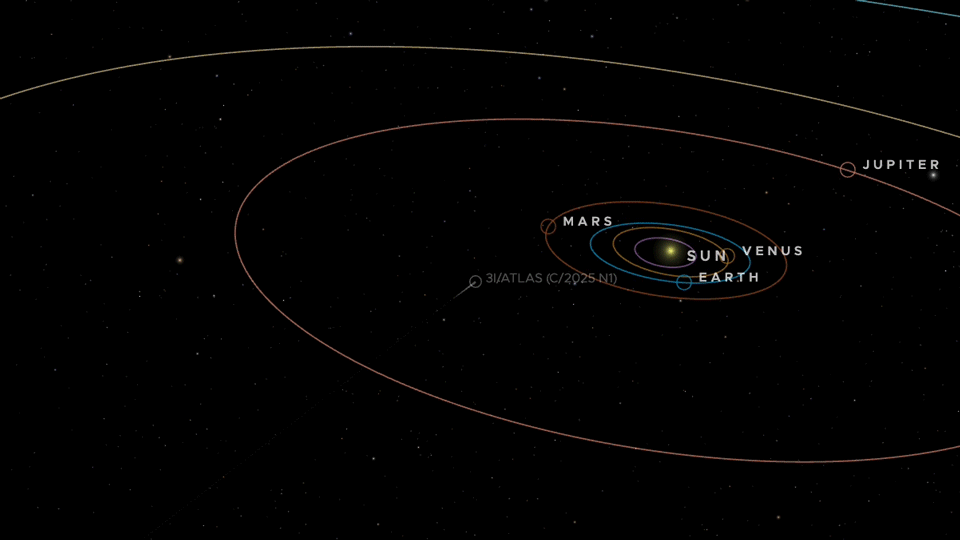Cronología de 3I/ATLAS
Siga el viaje del Cometa 3I/ATLAS desde su descubrimiento a través de su paso por nuestro sistema solar. Rastree eventos clave, observaciones e hitos científicos.

Esta animación muestra la trayectoria prevista y la apariencia del Cometa 3I/ATLAS mientras pasa por nuestro sistema solar. La alta velocidad del cometa y su órbita hiperbólica lo convierten en un visitante único de otro sistema estelar.
Cometa 3I/ATLAS descubierto por el Sistema de Última Alerta de Impacto Terrestre de Asteroides (ATLAS) en Chile.
Detalles Clave:
- • Detectado inicialmente como un objeto de movimiento rápido con trayectoria inusual
- • Magnitud inicial de aproximadamente 13,2
- • Designado como potencialmente interestelar basado en características orbitales
- • Sistema de telescopios ATLAS: telescopios Schmidt de 0,5 m con campo de visión de 5,4°
- • Coordenadas de descubrimiento: AR 12h 34m 56s, Dec -45° 12' 34"
- • Excentricidad orbital inicial calculada como e > 1,0 (hiperbólica)
Notas Técnicas:
- • ATLAS utiliza dos telescopios de 0,5 metros en Hawái y Chile
- • Cada telescopio puede escanear todo el cielo cada dos noches
- • Diseñado para detectar asteroides y cometas cercanos a la Tierra
- • Descubrimiento confirmado por observaciones de seguimiento dentro de las 24 horas
El análisis orbital confirma a 3I/ATLAS como el tercer objeto interestelar confirmado.
Detalles Clave:
- • Órbita hiperbólica con excentricidad e ≈ 6,3 confirmada
- • Velocidad relativa al Sol: ~58 km/s
- • La trayectoria indica origen del disco grueso de la Vía Láctea
- • Período orbital: hiperbólico (no ligado al sistema solar)
- • Inclinación: 45,2° relativa al plano de la eclíptica
- • Argumento del perihelio: 123,7°
Notas Técnicas:
- • Tercer objeto interestelar confirmado después de 1I/'Oumuamua y 2I/Borisov
- • Cálculos orbitales basados en un arco de observación de 2 semanas
- • La velocidad excede la velocidad de escape del sistema solar por un factor de 2,5
- • Origen probable de otro sistema estelar en nuestra galaxia
Gemini Norte y otros observatorios importantes comienzan observaciones sistemáticas.
Detalles Clave:
- • El análisis espectroscópico revela una coma dominada por CO₂
- • Tamaño del núcleo estimado entre 0,32 y 5,6 km
- • Sin detección significativa de hielo de agua en las primeras observaciones
- • Telescopio Gemini Norte de 8,1 m: instrumentos NIRI y GMOS
- • Diámetro de la coma: ~15 segundos de arco en el descubrimiento
- • Tasa de producción: Q(CO₂) ≈ 10²⁶ moléculas/segundo
Notas Técnicas:
- • Observaciones en múltiples longitudes de onda desde UV hasta infrarrojo cercano
- • La espectroscopia de alta resolución revela la composición molecular
- • La fotometría muestra variaciones rápidas de brillo
- • La morfología de la coma sugiere regiones de desgasificación activa
El cometa muestra mayor actividad al acercarse al Sol, desarrollando una coma visible.
Detalles Clave:
- • La magnitud brilló a ~12,5
- • El diámetro de la coma aumentó a ~30 segundos de arco
- • Posible coloración verde detectada en algunas imágenes
3I/ATLAS alcanza su punto más cercano al Sol a 1,36 UA.
Detalles Clave:
- • Aproximación más cercana al Sol: 1,36 UA
- • Se espera máxima actividad y brillo
- • Comienza el período óptimo para estudios espectroscópicos
El cometa alcanza su magnitud aparente máxima, estimada alrededor de 11,5-12,0.
Detalles Clave:
- • Magnitud máxima esperada: 11,5-12,0
- • Mejores oportunidades fotográficas
- • El desarrollo de la cola puede ser visible
3I/ATLAS realiza su paso más cercano a la Tierra a 1,8 UA (270 millones de km).
Detalles Clave:
- • Distancia mínima: 1,8 UA (270 millones de km)
- • Mejor geometría de observación para estudios detallados
- • Momento óptimo para observaciones de aficionados
El cometa comienza a desvanecerse a medida que se aleja del sistema solar interior.
Detalles Clave:
- • La actividad disminuye a medida que aumenta la distancia al Sol
- • La magnitud cae por debajo de 13,0
- • Últimas oportunidades para observaciones detalladas
Últimas observaciones antes de que 3I/ATLAS se vuelva demasiado tenue para la mayoría de los telescopios.
Detalles Clave:
- • La magnitud cae por debajo de 14,0
- • Solo los grandes telescopios pueden rastrear el cometa
- • Fin del período de observación amateur
Esta línea de tiempo rastrea los eventos clave en la observación y estudio del Cometa 3I/ATLAS. Las fechas marcadas como "próximo" son predicciones basadas en los cálculos orbitales actuales y pueden actualizarse a medida que haya nuevos datos disponibles.
Las fuentes incluyen anuncios oficiales de agencias espaciales, investigaciones revisadas por pares y observaciones de astrónomos profesionales y aficionados de todo el mundo.
Explorar Multimedia de 3I/ATLAS
Descubra impresionantes imágenes, videos y visualizaciones del Cometa 3I/ATLAS capturadas por observatorios de todo el mundo. Sea testigo de la belleza de este visitante interestelar.

Galería Multimedia Completa
Navegue por nuestra extensa colección de imágenes, videos, animaciones y visualizaciones científicas de 3I/ATLAS. Desde fotos del descubrimiento hasta análisis espectroscópicos detallados, explore cada aspecto de este notable visitante interestelar.


